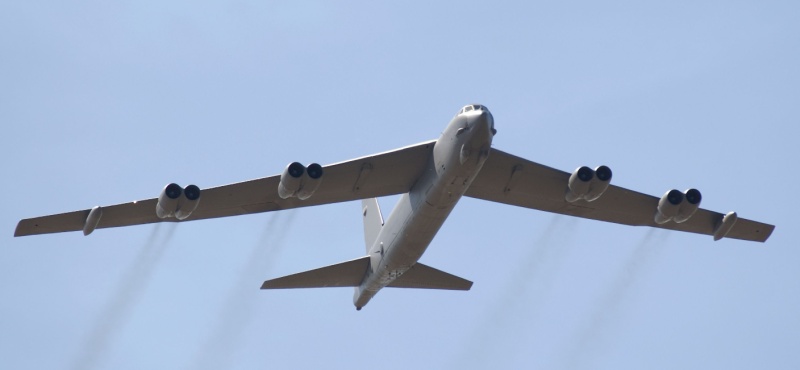B-52 bombers from Louisiana recently landed in Diego Garcia to “showcase our capability for rapid deployment in support of the combatant commander’s objectives,” said Maj. Joshua Dawkins, 96th Bomb Squadron director of operations.
Throughout this deployment, the heavy bombers will integrate alongside Allies and partners throughout the region to demonstrate and strengthen a shared commitment to security and stability in the Pacific region.
The direct flight from Barksdale AFB to Diego Garcia lasted approximately 30 hours and demonstrated the B-52’s strategic flexibility and global reach.
The Military and Diego Garcia
Portuguese explorer Pedro Mascarenhas “discovered” Diego Garcia, and the other islets in the Chagos Archipelago, in 1512. However, because of the island’s remote location (in the middle of the Indian Ocean) and small size, no European power colonized it until the 1780s. The French, which controlled the nearby island group of Mauritius, established a small outpost on Diego Garcia which alternated between a commercial outpost and a leper colony.
France ceded Mauritius, and therefore Diego Garcia as well, to Great Britain after the Napoleonic Wars ended in 1814. This transfer of power started the difficult relationship between Diego Garcia and the world’s major military powers.
For the next century-and-a-half, Diego Garcia remained part of Mauritius. Then, in 1965, shortly before Mauritius became an independent nation, the British unilaterally moved Diego Garcia into the British Indian Ocean Territory. The development of high-speed jet aircraft, political instability in South Asia between India and Pakistan, and several other developments had transformed Diego Garcia from a rock no one wanted into a valuable military outpost that everyone wanted.
In early 1965, the British began buying up land on Diego Garcia, so they could build a naval base there. The British then immediately leased this base to the United States.
At that time, about 1,000 Chagos islanders lived on Diego Garcia. No one is sure where these people originally came from. Then, as the Americans expanded the naval base in the late 1960s and early 1970s, the British and Americans forcibly expelled the Chagos people. Many were deported to Mauritius and the Seychelles
Many years later, the International Court of Justice ruled the aforementioned reclassification was illegal and the atoll, including Diego Garcia, rightfully belonged to Mauritius. The British dismissed the outcome as an advisory opinion.
This controversy makes Diego Garcia the poster child for militarism and colonialism, at least according to some. Military/colonial powers all too often say this land is our land, we’ll do what we want when we want, and if people get hurt in the process, that’s too bad.
What Contractors Do
The hundreds of private military contractors who live and work on Diego Garcia are mostly construction and security contractors.
Many of Diego Garcia’s facilities have not been significantly updated since they were built during the Cold War era. Today’s weapons and aircraft are infinitely more advanced. Runways need lengthening, harbors need expanding, and the list goes on. Construction contractors are usually on-site supervisors. They keep the project moving so it is done according to specifications, on time, and under budget.
Other construction contractors renovate and expand barracks and common areas. Deployment to a remote area like Diego Garcia is a tough pill to swallow. If the facilities are up to date, the time passes more quickly. Furthermore, up-to-date facilities are tangible evidence that the higher-ups care about what ordinary soldiers, sailors, and contractors must endure.
The isolation of Diego Garcia contributes to many alcohol-related offenses. Frequently, contractors help the provost deal with these matters quietly yet effectively.
Injury Compensation Available
These assignments are dangerous. Construction is consistently at or near the top of the “most dangerous jobs” lists that appear from time to time. Furthermore, people who drink behave erratically. There is simply no telling how they will respond to a certain situation.
Compounding these injuries, limited medical assistance is available on Diego Garcia. The atoll’s medical facilities are more like first-aid stations. Extensive injury treatment means evacuation to a larger medical facility that’s usually in the Middle East or Australia. The long flight aboard a flying hospital could easily add tens of thousands of dollars to the medical bills in an injury case.
Because of the delayed treatment, the victim’s injuries are usually more difficult and expensive to treat. However, many insurance companies do not take this factor into account when they determine what medical expenses are reasonably necessary. More on that below.
The “reasonably necessary” standard is very subjective. This standard requires plaintiffs to show they received necessary medical services because of the defendant’s actions or negligence and that the cost was reasonable for the services. This confusing yet widely used definition uses the term “reasonably necessary” to define “reasonably necessary.”
Many insurance adjusters interpret the subjective definition to mean “average” is the same thing as “reasonable.” But that’s not true in most cases, especially regarding injuries that occur in remote locations.
- Transportation: Front-line medical centers stabilize patients for transport but do not address their underlying injuries, such as head injuries. As a result, by the time a doctor sees the victim, usually more than twelve hours later, the underlying injuries have degraded.
- Emergency Care: The same principle applies to emergency care. Doctors must use more aggressive means than normal to treat these wounds. These aggressive methods are more expensive than average. So, the boilerplate actuarial tables most adjusters use do not apply.
- Follow-Up Care: This aggressive treatment normally means doctors must perform several smaller surgical proceedings instead of one long one. That is not a cost-effective approach, but doctors cannot concern themselves with such matters. They must do what’s best for their patients, regardless of the cost.
Injured contractors may choose their own doctors. So they can be sure that they get the treatment they need, as opposed to the “average” treatment for their injuries.
For more information about lost wage replacement, contact Barnett, Lerner, Karsen, Frankel & Castro, P.A.

